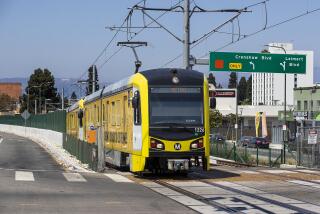Bullet train change a blow to O.C.
In a blow to Orange County’s hopes for a boost to business and tourism, the California bullet train project has dropped a link to Anaheim from its current, $68-billion plan.
The rail agency confirmed the shift Friday, marking a significant departure for the Bay Area-to-Southern California high-speed rail system that state voters approved in 2008.
Under newly revised plans, the first phase of the line would have its southern terminus near downtown Los Angeles rather than in Orange County.
Bullet train passengers would have to transfer to slower Metrolink or Amtrak trains in Los Angeles to reach Orange County’s largest city. Until now, officials had vowed that under the first phase, the bullet trains would whisk riders about 40 miles southeast of downtown to the Disneyland area.
Walt Disney Co., which operates the state’s largest tourist attraction, has been a strong advocate for the project in the past. And Anaheim saw the bullet train as a centerpiece of a massive, $200-million transportation hub, known as ARTIC, near Angel Stadium. Anaheim is set to seek bids for the transit center next month.
Electrifying and improving the Los Angeles to Orange County route would cost $6 billion and save only 10 minutes of travel time, said rail authority Chairman Dan Richard.
“Why would we do that, pay $600 million per minute?” he said in an interview Friday.
Richard said the savings to be achieved by dropping an Anaheim link from the initial construction plans made financial sense.
At least some Orange County officials agreed.
“It was never realistic to come to Anaheim,” said Orange County Supervisor Shawn Nelson, whose district includes the city. “For four years, I’ve been saying the thing is never coming to Anaheim. To electrify the system accomplishes nothing.”
But Anaheim Councilwoman Kris Murray said it’s crucial that the bullet train reach her city and its tourist attractions and professional sports teams
“The state of California is growing at a fast clip,” she said. “We need to have transit as well as highways.”
It is unclear under the new proposal if or when bullet train service would be extended to Anaheim. The $68-billion project is supposed to be completed by 2028.
It was partly the elimination of service from downtown’s Union Station to Orange County that helped slash the project’s price tag by $30 billion, said Lance Simmens, a spokesman for the California High-Speed Rail Authority. Until the recent revisions, the estimated cost of linking the Bay Area to Anaheim was nearly $100 billion.
The politically sensitive change had not been immediately evident Monday when the new plan was unveiled because the report did not explicitly state it. But a series of passages makes clear that the reduced budget would not cover costs of dedicated high speed tracks or electrical systems needed to operate bullet trains between Los Angeles and Anaheim. Other language in the plan suggests that an expanded future project or a second phase could reach Anaheim.
Assemblywoman Diane Harkey (R-Dana Point), a longtime critic of the project, said she wasn’t surprised by the decision because the rail agency is “trying to count votes right now, and Los Angeles, San Francisco and the Bay Area is where they will find them, if they exist. Anaheim was always a secondary thought.”
Indeed, while key local and state politicians from the Bay Area have played major roles in the bullet train project, Los Angeles and Orange county officials have been less prominent. At least two major lawsuits in the Bay Area have challenged the rail’s route, for example.
In recent months, the rail agency has attempted to shore up flagging public and political support by adopting a “blended system,” which would improve existing commuter rail systems in the San Francisco and Southern California regions. Those would connect to a backbone of high-speed service in the central area of the state.
Under the new plan, Metrolink would get significant investments along its lines from the San Fernando Valley to Anaheim. Meanwhile, the Caltrain system in the Bay Area would get a massive investment to electrify its system from San Jose to San Francisco.
Some high-speed rail proponents have attacked the blended service plan as a way for local transportation agencies to siphon away money intended for bullet train construction.
But other rail advocates praised the new approach.
Paul Dyson, president of the Rail Passenger Assn. of California and Nevada, praised the lower priority given to running high-speed trains between Anaheim and Los Angeles.
“The choice of Anaheim was politically driven,” he said. “It doesn’t make any sense as a terminus.”
Don Sepulveda, executive officer of regional rail for the Metropolitan Transportation Agency, predicted that high-speed trains would eventually run between Los Angeles and Anaheim and share track with Amtrak and Metrolink. But electrification of the route, which is required for bullet trains, will not happen until after the system reaches Union Station.
“It is now a lower priority, but I believe it will eventually be electrified. It will not be a feeder line for high-speed rail,” he said.
John Fenton, the chief executive of Metrolink, said the current business plan offers the best solution.
“I like the idea of the blended approach because they are going to make investments in Metrolink,” he said. “This way we are getting more bang for the buck.”
But those investments are a violation of the voter-approved proposition, said Elizabeth Alexis, a co-founder of Californians Advocating for Responsible Rail Design, a Bay Area group.
--
dan.weikel@latimes.com
Times staff writer Rick Rojas contributed to this report.
More to Read
Sign up for Essential California
The most important California stories and recommendations in your inbox every morning.
You may occasionally receive promotional content from the Los Angeles Times.












